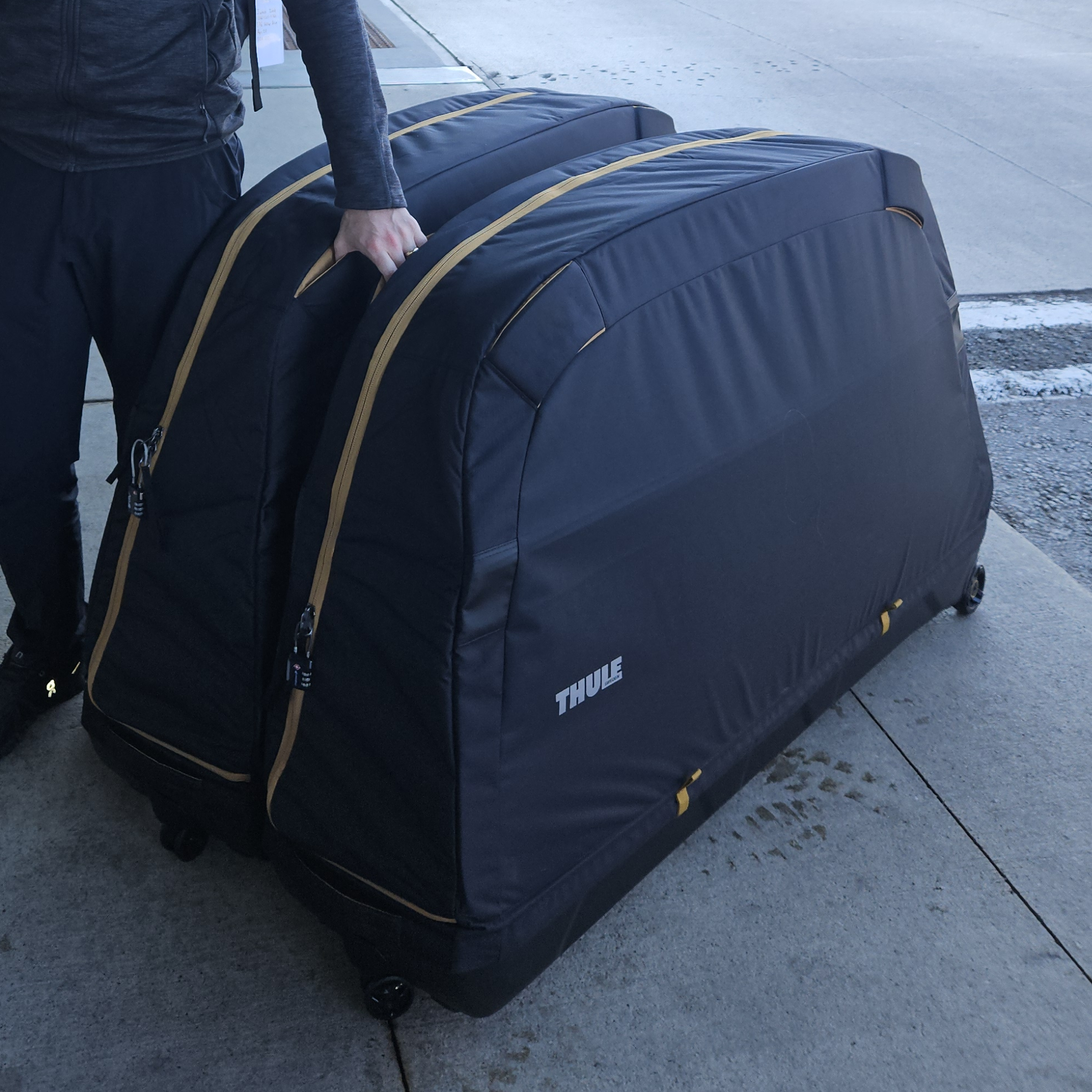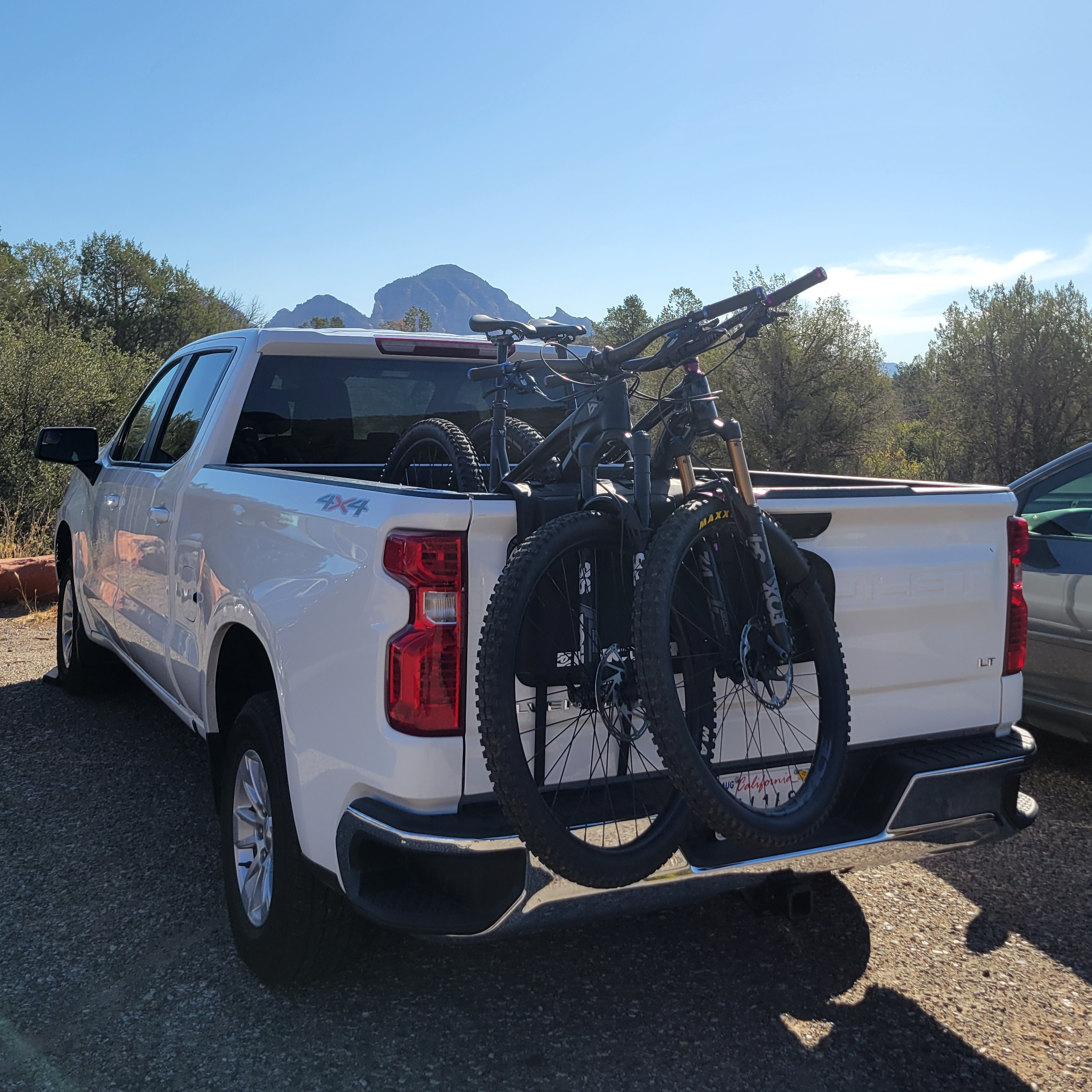Air Travel with Mountain Bikes
Traveling with mountain bikes may sound daunting, but with a few tips and tricks, it is much easier than you may think. From packing your bike to finding the right transportation at your destination, this guide covers everything we’ve learned about flying with bikes.
Packing Your Bike
After thorough research, we decided to transport our bikes with Thule Round Trip MTB Travel Bags. The integrated stand makes disassembly and assembly a breeze, and the case is built in a way to protect the most sensitive parts on your bike better than any others on the market. As a bonus, it packs up small when not in use.
The Round Trip is compatible with virtually any mountain bike. The base is long enough to accommodate slack, XL mountain bikes and wheel pouches can handle our 29” x 2.6” tires comfortably.
Packing
Using the Round Trip is pretty straight forward. There are good videos online, but here’s a quick summary of the steps required:
- Compress dropper post, or lower your seat if you don’t have a dropper.
- Air down the suspension and tires to about 50% of normal pressures. (Airlines dislike high-pressure items, and it’s safer for your gear.)
- Remove the wheels and set aside
- Secure bike in bike stand
- Unhang derailleur if your bike is longer
- Remove bike from rack and install in base
- Wrap bike with the included padding.
- Undo the stem bolts and remove handlebars, hanging them in the secure position
- Secure wheels in dedicated positions on the padding.
Assembly is essentially the same, in reverse order, but be sure to torque all bolts to the correct spec!
Tools to Bring
When flying with bikes, a basic tool kit is required for assembly, disassembly, and maintenance. Here’s what we pack:
- High pressure hand pump: For your shock and fork, it should have an integrated gauge.
- Low pressure hand pump: For your tires and for the trailside. An option that fits in your pack or on your bike frame is best.
- A ratcheting multitool: To disassemble your bike. We use a Topeak set with chain tool.
- A torque wrench: To reassemble your bike. We use a Topeak model that comes with a case.
You will also want to remember to pack your typical emergency kit:
- Spare tube
- Standalone pressure gauge
- Multitool
- Tire levers
- Tire boots
- Tire sealant (1oz bottles only)
- Basic first aid kit
Remember that not all gear is safe for air travel. You’ll want to leave your CO2 cartridges and bear spray at home, lest it be confiscated prior to boarding.
Choosing the Right Airline
Choosing the lowest price airline is rarely the best plan when flying with bikes. It’s important to consider equipment handling policies and prices when you’re selecting flights.
Verify that your packed bike meets the airline’s weight and size dimensions. Some airlines only allow enough weight for road bikes in leaner cases, while others are more accommodating. Also note that the prices vary wildly between airlines, with premium airlines typically charging less.
Transportation at Your Destination
When we arrive, we usually rent a truck to transport our bikes and gear. Bike cases are large enough that they will not fit in a car, and rarely fit in midsize SUVs. Large SUVs, trucks, or vans are your only option when transporting your bikes packed in their luggage.
Keep in mind that when renting a vehicle, models are not normally guaranteed and are subject to availability. If available in the area, Enterprise’s truck-specific rental site is a service that you can use to guarantee a truck rental at the time of arrival. If that fails, Turo is a good option for selecting a vehicle that meets your needs.
Once the bikes are reassembled after the flight, we use a Race Face 2-bike tailgate pad that we packed in our general luggage. It’s small, lightweight, and makes it easy to transport bikes without rack rentals and constant disassembly and reassembly.

Bikes packed in the Thule Round Trip case

Bikes assembled and on the Race Face tailgate pad
If you are travelling to a country that has better transit and less availability of larger vehicles for rent, then you will likely find yourself travelling by train. Note that trains transport bikes significantly better when packed in their case, packing them as they would any other luggage. Many trains have dedicated space for assembled bikes, but the burdon of walking with your luggage, assembled bike, and packed-down bike case makes this option unfeasible. We have yet to do this ourselves, and will update this with more details when we have the chance to!
Gear Storage
For our helmets, tools, and protective gear, we rely on the Nanuk 965 Protective Case. It’s large enough to fit two full-face helmets, an additional pair of half-shell helmets, hydration packs, body armor, and more, all while staying under airline weight limits.
We opted for the foam option and installed custom cut ½” foam siding to prevent helmets from contacting the sides of the case.
It’s an expensive option, but we feel the ability to pack more than just a pair of full head helmets as a piece of your limited checked luggage is well worth the cost. Do note that like the bike bags, this case is considered oversize luggage and may take longer to check at some airports.
Planning Your Trip
When it comes to planning, we focus on activities, not rigid itineraries. Weather, trail conditions, and even how you’re feeling after a big ride can be unpredictable.
Here’s how we approach it:
- Research all the activities you’d like to do in advance.
- Each morning, decide what works best based on the weather and how you’re feeling.
- Plan for more activities than you have time for and prioritize your must-dos.
This flexible approach allows us to get the most out of our trips without feeling stressed or overcommitted.
Recovery Time
After a long day on the trails, there’s one thing we always prioritize: hot tubs. A good soak helps with recovery, eases sore muscles, and lets you relax after the ride. If you can find accommodations with a hot tub, it’s a worthwhile addition to your trip.
Always bring plenty of electrolytes with you. Pick up bottles of Gatorade once you’ve settled in, or bring some powdered options (LMNT, Gatorade) from home.
Final Thoughts
Traveling with bikes might seem complicated, but with the right gear and preparation, it becomes second nature. Whether you’re flying across the country or internationally, these guidelines will help ensure your trip starts and ends on a high note.

